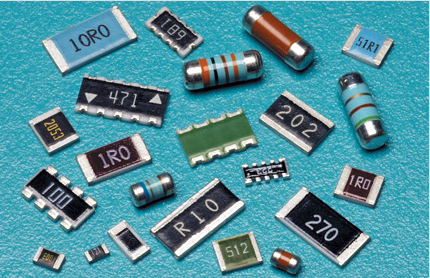Position:Home » Industry News
Choose Right Resistor for Different Applications
Writer:Microhm Page View:Date:2020-01-10
One of the most common components that every professional or hobbyist circuit designer encounters is to choose trusty electrical resistors from resistor manufactures as Microhm Electronics. A resistor’s job is to convert electrical energy, either DC or AC, into thermal energy by having higher resistance than the typical electrical conductor used in a circuit. By doing so, they can control the current flow through or voltage drop across them, offering a handy way to manipulate such things in an electronic circuit. In fact, it’s fairly easy to combine resistors to achieve the specific current value desired or to structure resistor networks to achieve a specific voltage, which is why these devices are so common.
Given this broad definition, though, there can be many types of resistors that optimize different features of this component, including cost, power-handling, size, weight, temperature range, high reliability, accuracy, noise, and frequency response. These many types of resistors offer a wide range of strengths and weaknesses.

Typically, though, when just the term “resistor” is used, it implies either a through-hole or surface-mount (SMT/SMD) linear, fixed resistor. But within this smaller category, there are still a multitude of types with very different physical and electrical properties.
Through-hole resistors of many sorts have a wire either coming from the bottom or sides of the resistor body. These are the type that come in many DIY kits and are responsible for many soldering iron burns. Yet even these resistors come in many shapes and sizes. It’s likely that anyone who has purchased a few resistors hasn’t accidentally overlooked the mechanical drawing in a datasheet to confirm the actual size and shape of a resistor. With through-hole resistors, the size and resistance or power rating are sometimes correlated, sometimes not. This makes checking the datasheet mechanical drawing necessary if footprint is a consideration. Sometimes it makes for an ugly and hard-to-troubleshoot circuit if the resistor has to take on a yoga position to fit via hole spacing that’s much smaller than its body. Microhm Electronics always check wihth customers about the resistance value, watt, tolerance, TCR as well as voltage and size.

SMD resistors are some of the small black squares on a highly dense or small-form-factor PCB. Hobbyist projects may contain professionally assembled parts with SMD resistors, but without the right hot air or specialized soldering tools, SMT resistors are difficult to work with. These resistors usually have much lower power handling and are much smaller than through-hole resistors. Microhm Electronics MPR series, NMS series, LMK series are all SMD resistors.
There is another type of resistor less commonly encountered, which is the screw-mounted or bracket-mounted resistor. These are typically used in high-power, high-reliability, or testing scenarios in which precise resistances with low noise operate at DC or with low-frequency signals, such as NUAL series.
Given this broad definition, though, there can be many types of resistors that optimize different features of this component, including cost, power-handling, size, weight, temperature range, high reliability, accuracy, noise, and frequency response. These many types of resistors offer a wide range of strengths and weaknesses.

Typically, though, when just the term “resistor” is used, it implies either a through-hole or surface-mount (SMT/SMD) linear, fixed resistor. But within this smaller category, there are still a multitude of types with very different physical and electrical properties.
Through-hole resistors of many sorts have a wire either coming from the bottom or sides of the resistor body. These are the type that come in many DIY kits and are responsible for many soldering iron burns. Yet even these resistors come in many shapes and sizes. It’s likely that anyone who has purchased a few resistors hasn’t accidentally overlooked the mechanical drawing in a datasheet to confirm the actual size and shape of a resistor. With through-hole resistors, the size and resistance or power rating are sometimes correlated, sometimes not. This makes checking the datasheet mechanical drawing necessary if footprint is a consideration. Sometimes it makes for an ugly and hard-to-troubleshoot circuit if the resistor has to take on a yoga position to fit via hole spacing that’s much smaller than its body. Microhm Electronics always check wihth customers about the resistance value, watt, tolerance, TCR as well as voltage and size.

SMD resistors are some of the small black squares on a highly dense or small-form-factor PCB. Hobbyist projects may contain professionally assembled parts with SMD resistors, but without the right hot air or specialized soldering tools, SMT resistors are difficult to work with. These resistors usually have much lower power handling and are much smaller than through-hole resistors. Microhm Electronics MPR series, NMS series, LMK series are all SMD resistors.
There is another type of resistor less commonly encountered, which is the screw-mounted or bracket-mounted resistor. These are typically used in high-power, high-reliability, or testing scenarios in which precise resistances with low noise operate at DC or with low-frequency signals, such as NUAL series.
Latest News
- Resistor's role in measuring and correcting LED,,,
- Single through-hole resistors' characteristics ,,,
- Why shunt resistors for current sense applicati,,,
- Metal-film resistors with small size, high resi,,,
- 36W High-Current Shunt Resistors MMS8420,,,
- 1W Surface Mount Resistor MPR1206,,,
- An Overview of Microhm Electronics' Resistor Pr,,,
- More anti-sulfur resistors used in harsh envir,,,
- Resistance changes with temperature,,,
- 140W TO247 High Power Heatsinkable Resistor,,,
- MMS5930 is ideal for current sensing in industr,,,
- Shunt resistors selection for engineers' design,,,
- Considerations for choosing precision resistors,,,
- Ceramic Encased Cement Resistors NWH Series for,,,
- Resistors for Passive Balancing in Battery-Pow,,,
Hot Articles
- Microhm will take part in 10th Automotive World,,,
- Thanks for Visiting Microhm's Booth E5-5706 in ,,,
- Resistors in Short Supply: Blame Cars,,,
- New lunch: High Power Precision Shunt Resistor,,,,
- How to Test a Resistor,,,
- Innovative Technology, Future Electric: Electri,,,
- What is Precision Resistors?,,,
- SMD Resistors Sizes and Packages,,,
- The Construction and Features of Metal Film Res,,,
- What is a TO-220 Resisor?,,,
- Hot Selling Products: Precision Shunt Resistors,,,
- How to Calculate the Equivalent Resistance Valu,,,
- What is a Fixed Resistor?,,,
- Resistors in LED Circuits,,,
- Resistors Types and Materials Overview,,,
Resistance applications
- Urbanization Development Bringing the Transform,,,
- Heater Blower Motor Resistor in Air Conditioner,,,
- BMS for New Energy Vehicle,,,
- Select the Right Resistor for Harmonic Filterin,,,
- Why Zero-Ohm Resistors?,,,
- Surface Mount Resistor's Size and Package ,,,
- The Main Application for High Precision and Low,,,
- Precision Resistors' Construction and TCR,,,
- Industrial Roberts Applied to Solar Photovoltai,,,
- Carbon Film Resistors' Features and Application,,,
- Miniature future for passive electronic compone,,,
- The Measurement Accuracy of Automotive Shunt is,,,
- The Four Important Functions of Alloy Resistors,,,
- Shunt Resistor MMS8420 for High Current Stable ,,,
- Difference Between High Precision Resistors and,,,
